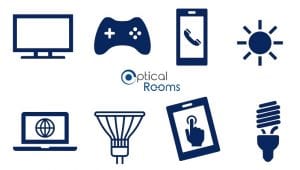BlueLite Glasses
COMPUTER GLASSES: BLUE LIGHT GLASSES EXPLAINED
Are you using or exposed to any of the following on a daily basis?
Why are they potentially harmful?
Exposure to blue light can cause the following:
- Formation of destructive free radicals at the retina
- Blurred vision
- Dry eyes
- Headaches
- Eye strain & fatigue
How can we help?
We regularly have patients at our clinics complaining about eye strain and dry eye. These days, because we spend so much time on digital devices, this is a common problem. In fact, in a survey it was found that over 70% of adults reported having some kind of digital eye strain (strained, dry or red eyes; blurred vision; headaches; back pain; neck pain; or general fatigue) as a result of using digital devices for hours at a time.
It has been proven that damage from blue light and HEV is accumulative, slowly over a lifetime, reaching a point typically in our late 60’s/early 70’s as macular degeneration. So we know the exposure effects are a function of the intensity of the light interring our eyes and the amount of time our eyes are exposed to this light. Interestingly if you look at the spectrum of light from LED bulbs, the light you may have in your kitchen versus the natural sunlight spectrum, there is a very obvious spike and increased intensity at the blue end of the spectrum, almost an unnatural spike in comparison to the natural daylight spectrum.
If you work in an office job, it´s highly likely that you get that classic mid-afternoon eye strain – that twitch, dry and altogether sore and burning sensation.
Have you ever considered getting computer glasses? These are glasses specifically designed to delay damage to your eyes if you are chained to your computer screen eight-plus hours a day.
What do blue control computer glasses do?
Blue Control lenses work to filter out blue light. So now I can hear you yelling at your screen-
“WHAT IS BLUE LIGHT?”
Blue light is the type of light emitted from digital screens, made up of a very short wavelength that produces a high amount of energy. Sunlight is made up of UV and blue light, as part of the visible light spectrum, but it’s the blue light that causes the most amount of damage as over-exposure to it can cause long-term problems in your retinas.
Computer glasses filter up to 50% of bad blue light away from your eyes and defect up to 90% of glare – shielding your eyeballs while you work.
Benefits of computer glasses for you?
- Alleviates blurred vision
- Reduces glare for a more comfortable and relaxed vision
- Neutralises blue light, minimizes eye strain and fatigue
- Helps reduce dry eye problems
- Minimizes headaches
- Enhances contrast perception offering a more natural colour experience
- Improves sleep quality
But do computer glasses actually work or are they a gimmick?
We have been prescribing Blue Control Lenses for many years. Our patients have said that when you look through them there aren´t any drastic changes – the screen looks normal, no brighter, no different. However, they have noticed that they suffer less from headaches, experience less eye pain, don´t have the feeling of scratch eyes and were less prone to twitching. Some have commented that they feel that they are sleeping better than before they got the glasses.
Another point worth noting is that Harvard research has shown a potential link with cancer and depression relating to blue light exposure.
An industry-standard report on the effects of harmful blue light on the eye came up with 3 facts
- Blue light (380-500 nm) poses significant retinal hazards
- Blue light (380 – 455 nm) filtering is recommended to reduce retinal light hazard
- Age, smoking low macular pigments and genetics are strong risk factors for AMD (age-related macular degeneration)
Finally…
Here are another couple of tips for you to employ to help your eye comfort whilst working on your computer –
20/20/20 Rule: Every 20 minutes, take a 20-second break and stare at something 20 feet away.
When using a computer, sit in your chair and extend your arm. Your palm should rest comfortably on the monitor.
